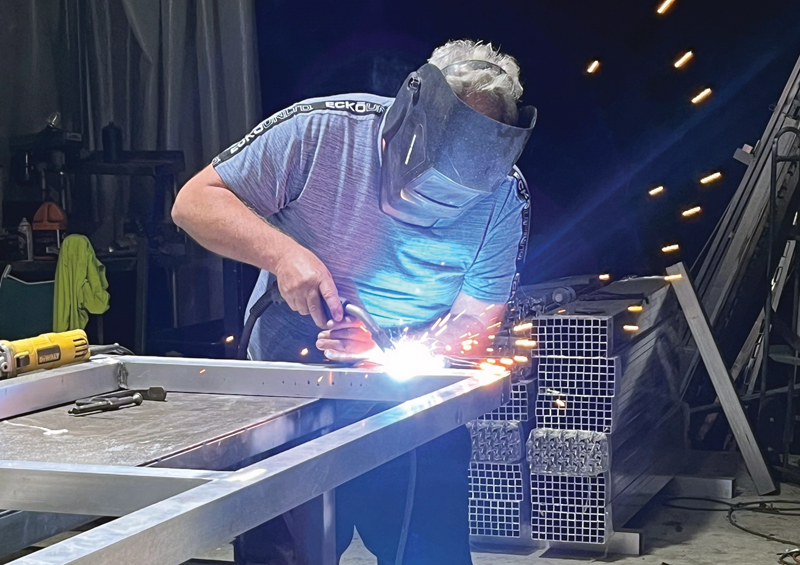A positive attitude makes adventures in boat repair more pleasant.
This may sound wacky, but I had a great time at a recent Lightning regatta that included three notable boat breakdown/repair adventures as well as a DNF and a DNS (in a seven-race series) that dropped us out of podium contention. By far the biggest takeaway from the three days was that sailing with calm, positive people not only makes having breakdowns more pleasant, but fosters a much healthier “let’s get this fixed” attitude that gets those repairs done.

The first day of the regatta featured three races in a light sea breeze that built to about 10-12 knots. Delightful. As we were crossing the downwind finish line, skipper Bill uncleated the line that pulls up the centerboard to put the board back down. There was a funny noise, and the board went back down much more quickly than planned. Forward crew Laura wriggled her way up into the bow of the boat to discover that the stainless eye strap that held one of the blocks for the centerboard purchase system had simply snapped in two. She was, through savvy and possibly a little magic, able to use some existing hardware up in the boat’s nose to get the purchase system back in action for us to start race three with smiles on our faces.
The second day, it was a bit windier, more like 15 knots, with some puffs. We were grinding back upwind working on passing some boats on the final leg of the first race of the day when the mainsail spontaneously came down. Bummer! The wire part of the halyard had failed at one of the balls. We reached back into the dock under jib, talking through our options and timing on the way. Laura again had a solution! It looked super tight on time, but we ended up capsizing the boat at the dock to tie the mainsail in its “up” position. More magic happened as while we did miss the second race of the day, we sailed back out to the starting area just before the warning signal for the third race sounded.
Back on shore after sailing, we took the mast down, as we of course needed to fish a new main halyard. That all went smoothly, but once we took the mast down, an asymmetry revealed itself: I noticed that the two lower chain plates (where the side shrouds attach to the deck) were different lengths. Lucky for us, Lightning boat builder and all-around super good human Tom Allen Jr. was at the regatta, so we asked him to look at it. His quick analysis was that it was not a good situation: The chain plate was likely cracked through underneath the fiberglass. That could spell disaster when hoisting the boat (the bridle used to lift the boat sits in the lower chain plates) or sailing.
Work started to fix the situation on a few fronts. Tom started grinding the chain plate out, while we searched for an after-hours stainless welder. Not as simple as it sounds. After a successful adventure a half hour drive away to meet a welder and late-night fiberglass work (thank you again, Tom!), the boat was back in action for the final race the next day.
In retrospect, none of those breakdowns offered any clues that they were about to happen—no discolorations in metal or fiberglass, no fishhooks in the halyard to indicate a broken strand. Even well-cared-for boats and parts can simply fail, as was the case at that regatta. Sometimes, parts are just “done,” and they break.
It got me thinking about ways to minimize risk. Both the centerboard purchase eye strap and the chain plate were stainless steel. Many people think that stainless is “set it and forget it” because hey, it’s stainless, it doesn’t rust so it’s never going to break… right?
Not necessarily so. Corrosion can happen where oxygen can’t freely circulate and where chloride salts and moisture accumulate. Think of spots on your boat where it’s hard to rinse your fittings or under fastener heads (which often end up with that little rusty ring). Corrosion can also happen more quickly in warmer temperatures. (Also, don’t use a stainless screw in aluminum and introduce any saltwater unless you want adventures through galvanic corrosion.) Bottom line here is that while stainless is remarkably robust and enduring, we can help our stainless parts out by rinsing them thoroughly with fresh water and helping them live dry lives when possible.
Other metals pose challenges, too. Aluminum can corrode: That’s the white grumpy looking stuff that often accumulates on the rivets on your mast or boom. Freshwater rinsing is important here, too.
With that in mind, I’m renewing my commitment to spend an extra few moments giving my fittings a little extra freshwater love on the regular!
By Kim Couranz
About the Author: SpinSheet Small Boat columnist for more than a dozen years, Kim Couranz has earned several national and world titles in Laser Radials (ILCA 6), Snipes, and Lightnings. She has also raced J/22s, J/24s, and Ynglings on an international level.




